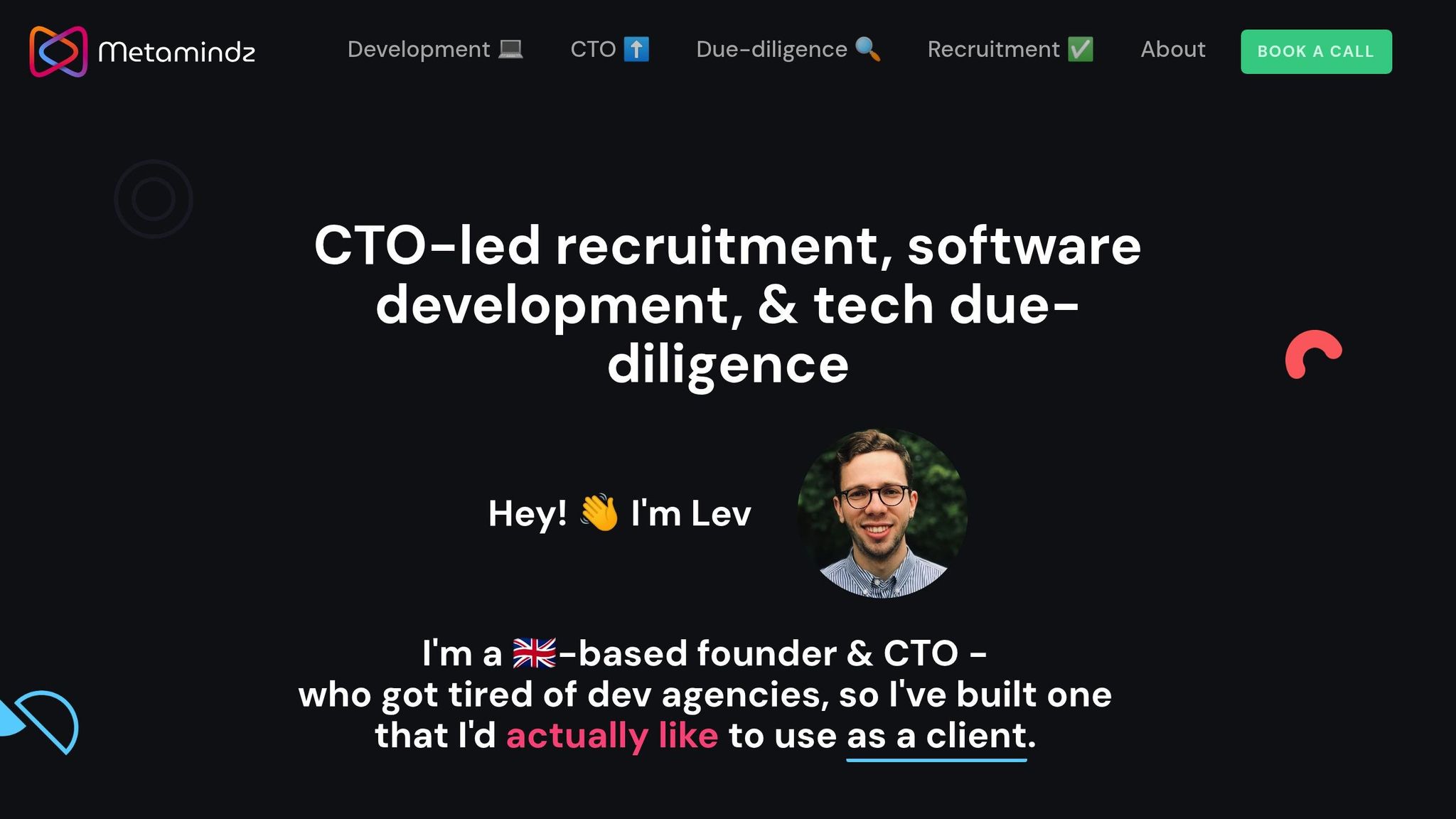AI Implementation Costs: Key Factors
- Major Cost Factors Associated with AI
- 1. In-House AI Development
- 2. CTO Service Providers (Metamindz)
- Cost Comparison Matrix
- Conclusion
- FAQs
- What are the benefits of using fractional CTO services, like those offered by Metamindz, for AI implementation instead of building an in-house team?
- What are the best ways to manage hidden costs in AI infrastructure and data preparation?
- What are the key steps in the initial technical evaluation for a successful AI project launch?

AI Implementation Costs: Key Factors
AI implementation costs depend on four main factors: data preparation, infrastructure needs, technical leadership, and development timeline. Here's a quick breakdown:
- Data Preparation: Cleaning, labeling, and standardizing data can be time-consuming and expensive.
- Infrastructure Needs: Cloud services, storage, and high-performance GPUs are essential but costly.
- Technical Leadership: Hiring a full-time CTO costs $18,000–$25,000/month, while fractional CTO services like Metamindz offer expertise for $3,500/month.
- Development Timeline: In-house development takes 6–8 months, while fractional CTO services can kick off projects in 6–8 weeks.
Quick Comparison:
| Cost Factor | In-House Development | CTO Service (Metamindz) |
|---|---|---|
| Initial Assessment | $15,000–$25,000 | $4,750 |
| Monthly Leadership Cost | $18,000–$25,000 | $3,500 |
| Annual Total | $366,000–$525,000 | $46,750 |
| Team Setup Time | 3–6 months | 2–4 weeks |
| Infrastructure Setup | $50,000–$100,000 | Included |
Fractional CTO services save costs, reduce timelines, and provide flexible leadership, making them ideal for startups and mid-sized businesses.
Major Cost Factors Associated with AI
1. In-House AI Development
Building AI systems in-house requires a hefty upfront investment in staff, infrastructure, and handling potential risks.
Personnel Costs
The largest expense comes from hiring skilled professionals like AI engineers, data scientists, MLOps specialists, and project managers.
Infrastructure Needs
Ongoing spending on technology is essential. This includes cloud computing platforms, data storage systems, and high-performance hardware like GPUs for demanding processing tasks.
These core investments often bring along hidden costs that can unexpectedly increase the overall budget.
Hidden Costs
There are several lesser-known expenses to consider:
- Data Preparation and Quality: Raw data needs constant attention - cleaning, labeling, and standardizing to ensure it stays useful.
- Technical Debt: As AI technology advances, older systems may need regular updates, retraining, and security improvements to stay relevant and efficient.
- Compliance and Security: Meeting regulatory standards and maintaining cybersecurity require audits, detailed documentation, and ongoing employee training.
Cost Mitigation Strategies
To manage these costs effectively, organisations can take a few proactive steps:
- Start with small, focused pilot projects to minimise risk.
- Use monitoring tools to track performance and prevent issues early.
- Define clear success metrics to measure progress.
- Maintain thorough documentation to improve efficiency.
- Standardise workflows to simplify and streamline processes.
2. CTO Service Providers (Metamindz)

Many companies turn to specialized CTO services as a way to manage costs while accessing high-level expertise. These services provide an efficient and budget-friendly alternative to maintaining an in-house team.
Cost Advantages
Fractional CTO services can help businesses save significantly. For example, Metamindz offers a fractional CTO subscription for $3,500 per month, a much lower investment compared to hiring a full-time executive.
Technical Evaluation
Before diving into AI development, a detailed technical evaluation - priced at $4,750 - can uncover potential issues and highlight areas for improvement. This step is crucial for making informed decisions about team structure and resource allocation.
Building High-Performing Teams
After the evaluation, the next step is assembling a skilled team. Fractional CTO services excel in recruiting and managing AI teams, reducing hiring risks and improving employee retention. As one satisfied client shared:
"Metamindz continuously helps the business to grow and serve customers properly by solving complex problems and tackling new challenges." - Leonid, Devalore [1]
Adapting to Project Needs
This approach allows businesses to scale leadership and resources based on the evolving demands of a project. It provides expert advice without requiring long-term commitments, making it a flexible solution.
Project Oversight
CTO service providers ensure smooth project execution by offering both technical and managerial expertise. They help maintain focus on strategic goals while keeping expenses under control:
"Metamindz manifests intricate analytical skills, deep technological capabilities and above all, high accountability." - Erez, Avante [1]
Reducing Risks
Technical due diligence services help organisations address potential challenges by:
- Assessing the current infrastructure's readiness
- Identifying and addressing technical debt
- Ensuring compliance and security standards
- Planning for scalability issues
sbb-itb-fe42743
Cost Comparison Matrix
Here's a detailed breakdown of the costs and timelines for in-house development versus using a CTO service like Metamindz.
Development Cost Comparison
| Cost Factor | In-House Development | CTO Service (Metamindz) |
|---|---|---|
| Initial Technical Assessment | $15,000 - $25,000 | $4,750 |
| Monthly Leadership Cost | $18,000 - $25,000 (Full-time CTO) | $3,500 (Fractional CTO) |
| Team Setup Time | 3-6 months | 2-4 weeks |
| Infrastructure Setup | $50,000 - $100,000 | Included in service |
| Annual Total | $366,000 - $525,000 | $46,750 |
Resource Allocation Breakdown
| Resource Type | In-House Model | CTO Service Model |
|---|---|---|
| Leadership Model | Dedicated full-time | On-demand expertise |
| Team Scalability | Fixed team size | Flexible scaling |
| Risk Management | Internal responsibility | Provider managed |
| Infrastructure Management | Internal team required | Included in service |
| Knowledge Transfer | Limited to internal team | Access to diverse expertise |
Implementation Timeline Comparison
| Phase | In-House Timeline | CTO Service Timeline |
|---|---|---|
| Initial Assessment | 4-6 weeks | 1-2 weeks |
| Team Assembly | 12-16 weeks | 3-4 weeks |
| Infrastructure Setup | 8-12 weeks | 2-3 weeks |
| Project Start | 6-8 months | 6-8 weeks |
Key Cost Considerations
- Infrastructure costs are included in the CTO service, eliminating extra expenses.
- Recruitment and training costs are significantly reduced.
- Technical due diligence has a fixed, predictable cost.
- Expenses are tailored to the specific needs of your project.
CTO services streamline costs and provide adaptable leadership, ensuring your AI budget is used efficiently.
Conclusion
The comparison highlights how the choice between building an in-house AI team and using fractional CTO services influences both costs and timelines. Fractional CTO services help cut annual leadership expenses while speeding up deployment and getting products to market faster.
This approach works especially well for startups and mid-sized businesses, offering access to experienced technical leadership through flexible subscription plans. It allows companies to make the most of their resources without sacrificing quality. As one client shared:
"Metamindz manifests intricate analytical skills, deep technological capabilities and above all, high accountability." - Erez, Avante [1]
By reducing overhead and accelerating deployment, fractional CTO services provide expert leadership while conserving resources. This option is particularly appealing to organizations aiming for quick AI implementation without the need for heavy infrastructure investment.
Ultimately, the best choice depends on factors like budget, timeline, and infrastructure. The urgency of deployment and specific technical needs will guide whether in-house development or fractional CTO services are the right fit for AI initiatives.
For many, fractional CTO services strike a balance between affordability and expertise, making them an increasingly popular choice for AI projects.
FAQs
What are the benefits of using fractional CTO services, like those offered by Metamindz, for AI implementation instead of building an in-house team?
Using fractional CTO services for AI implementation provides several advantages over building an in-house team. First, it offers cost efficiency, as you only pay for the expertise you need without the long-term commitment of full-time salaries and benefits. This can save companies thousands of dollars, especially during the early stages of AI adoption.
Second, fractional CTOs bring specialized expertise and industry experience right from the start. At Metamindz, for example, their professionals are skilled in AI strategy, technical due diligence, and scalable product development. This ensures your project is guided by seasoned experts who can avoid common pitfalls and accelerate timelines.
Lastly, fractional CTOs provide flexibility. They can adapt to your project’s evolving needs, whether it’s scaling infrastructure, refining AI models, or preparing for critical milestones like product launches or investor evaluations. This makes them an ideal choice for businesses seeking agility and high-quality results without the overhead of a full in-house team.
What are the best ways to manage hidden costs in AI infrastructure and data preparation?
Managing hidden costs in AI infrastructure and data preparation requires a proactive and strategic approach. Begin by assessing your current infrastructure to identify gaps and avoid over-investing in unnecessary tools or systems. Focus on scalable solutions that align with your long-term goals.
For data preparation, prioritize data quality over quantity to reduce processing time and storage expenses. Automating data cleaning and leveraging pre-trained models can also help lower costs. Additionally, consider working with experienced professionals or services to streamline complex processes and ensure efficient resource allocation.
By carefully planning and monitoring these aspects, companies can avoid unexpected expenses and maximize the return on their AI investments.
What are the key steps in the initial technical evaluation for a successful AI project launch?
To ensure a successful AI project launch, the initial technical evaluation should focus on a few critical steps:
- Define clear objectives: Identify the specific business problems the AI solution will address and establish measurable goals.
- Assess data readiness: Evaluate the availability, quality, and quantity of data. Ensure it is relevant, well-structured, and sufficient for training AI models.
- Evaluate technical infrastructure: Review your existing infrastructure to determine if it can support the computational requirements of AI, including storage, processing power, and scalability.
- Identify resource needs: Determine whether you have the necessary in-house expertise or if external support, such as fractional CTO services or specialized development teams, is required.
By thoroughly addressing these factors, you can reduce risks, optimize costs, and set the foundation for a successful AI implementation.
